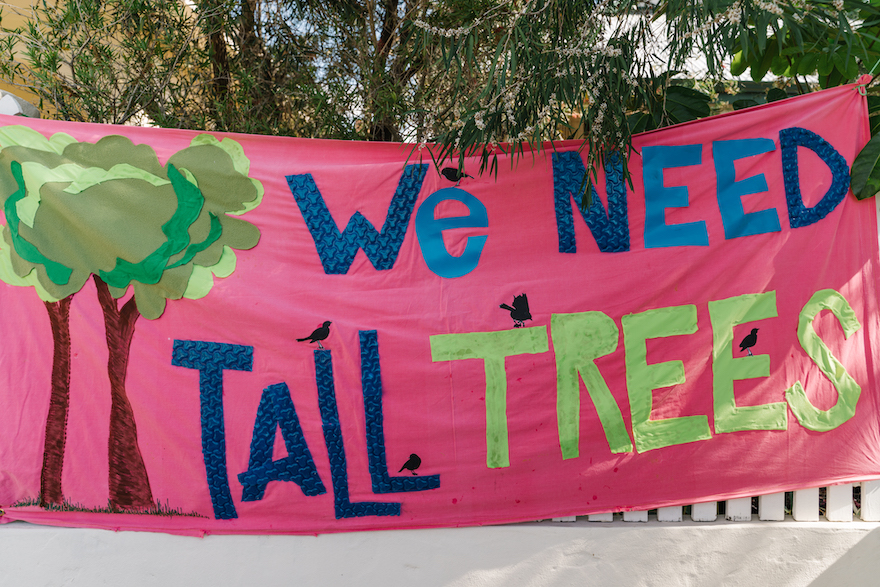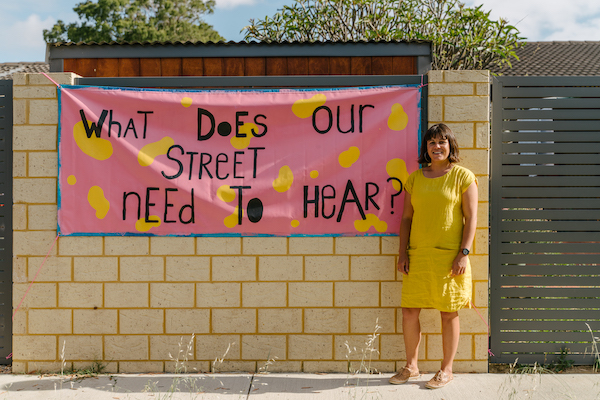Take a walk down Forrest Street in Fremantle over the next couple of weeks and you’ll notice something special. The street has been turned into a walking art gallery by local artist and resident Alex Desebrock. Nina Levy chatted to Alex to find out about the Forrest Street Banner Project, and the creative practice behind the work.
Take a walk on the art side
13 November 2020
- Reading time • 10 minutesVisual Art
More like this
- Waves of influence span an ocean
- A walk with Tina Stefanou
- A blaze of glorious people
Alex Desebrock is an independent artist living on Whadjuk Noongar land (Perth), Australia, whose work spans interactive theatre, live art, installations, online and public interventions. Her practice explores empathy, connecting strangers, big questions and smaller voices.
Alex is the founder of Maybe ( ) Together, which has presented works across Australia at the likes of Sydney Festival, Perth International Arts Festival, Awesome Festival and Arts Centre Melbourne.
Nina Levy: Alex, can you tell me about your work and Maybe ( ) Together?
Alex Desebrock: I am interested in work that intercepts the everyday, amplifies smaller voices and intervenes in public space. I am often returning to the question “What does the world need to hear?” and keep returning back to children as I do think they have a lot of excellent things for adults to hear/feel/play!
But I am also interested in finding space for quieter moments (the aMoment works), connecting strangers and empowering people through art. Maybe ( ) Together is a nod to the participatory nature of all my works. Maybe dance Together, Maybe write Together, Maybe hold hands Together, Maybe listen Together… to Maybe change the world Together.

NL: I feel that Maybe ( ) Together is unique in that it brings together a number of concepts – interactive work, work that asks big questions and work that amplifies the child’s voice. I think we see these individual concepts in other artists’ work… but not all together in one place. So I’m interested to know, how did Maybe ( ) Together come to be?
AD: I started Maybe ( ) Together in 2012 as an umbrella for all my works to sit under. I hardly ever work solo – there are other artists that come in and collaborate with me – so I see it more as a brand than “mine”. It started off with all these concepts you’ve mentioned.
I consider a real embedding of my practice took place when I worked at ArtPlay and saw so many artists working collaboratively with families. I learnt a lot. At the time, I was making playful works for adults and people kept telling me “oh this would be great for children” and I kept thinking – “No! adults need space to play, this is an adult work!” I then was watching a workshop at ArtPlay where a child was face-painting their dad’s face and the joy that was emanating from the dad was so big. That’s when the penny dropped – I need to make work for children that connects them with adults, because children are MUCH better at getting adults to play than I am!
As I worked on this concept more, I realised how little contact most people have with children beyond a parenting or teacher role; that these roles can prevent us from hearing children properly. Stranger Danger also stops random connections and so unless you have a child or work with children, you probably have little to do with them. Children can be very funny, super creative, insightful, hopeful and brutally honest. They also who we are leaving this world to, so can inspire us to do better.

NL: As you know, I’ve just written “Arts must stay young at heart”, an article about the importance of making work for children. When I was interviewing artists for the article, something that came up was this idea that the relationship between adult and child makers has the potential to be one in which both parties are enriched creatively. Can you tell me about how you see the potential of working cross-generationally, with young people and “adults”?
AD: Of course! Children’s brains are explosively creative and haven’t been conditioned to think in certain ways. (RIP Ken Robinson) All their brain patterns are firing and they make magic connections. We should be fostering that as a society, because we are certainly going to be needing some creativity in the future!
I believe that there is a certain synergy that occurs between artists and children. Artists can sit equal, alongside children – which subverts the usual adult roles of teacher or parent. They are our collaborator, our co-conspirator.
I’ve tried hard to ensure my works are empowering for the children involved, because I have found this to be key: when you have confidence in being a child (or just being you) – you start offering ideas and contributing. Coupled with art or artists, this is funnelled into creativity – which is where I feel magic happens.

NL: Your new project, Forrest St Banner Project, is an extension of your practice investigating the question, “What does the world need to hear?” Can you tell me about that broader investigation and what you’ve discovered so far in the course of that research?
AD: As a social artist, I feel that if I am going to make art, I need to consider what the world needs. Of course, there is no one thing that we all need. And it shifts and changes from moment to moment.What I like about it though is that it reminds us that we are all part of a world, and all have the ability to offer it something. Our world can be dominated by loud voices of media, marketing, government etc. But actually, this isn’t what we each need to hear, is it?
Social media is fast and loud. Words can seem disposable. However, if you consider this question, and answer via a postcard, a banner or step up and yell it to the world – we are more considered. It could be a statement, a question, a joke, a quote; anything.
A collection of answers to this question provides a snapshot of a time and place. You see what the “hot topics” are and what is culturally important. They are also generous and remind you that most people care a lot and we have more in common than not.

NL: And lastly, tell me about Forrest St Banner Project…
AD: So, I’ve always wanted to put banners in front of people’s homes and turn it into a walking art gallery along a street. When I shifted from renting to owning, I decided now was the time, as it would allow me to invest in the community that was around me. It was all quite serendipitous it’s happening just after/in the midst of COVID too – because we’ve all had a perspective shift on the importance of our street and local community.
Fourteen households along Forrest St, Fremantle replied to my flyer drop and have made banners responding to “What Does Our Street Need To Hear?” They each have a story. For example, one household has made a pride banner in honour of their two gay ducks, another made a “hello” banner because they’re new on the street, others have made statements about verge revegetation or the need for tall trees after the Stirling Highway development cut down many. Others are celebrations of their street, or their homes. And one of my favourites is 10 year old Bryn, who is the only male netballer in his team and wanted to make a banner that said “it doesn’t matter what gender, colour or passion. Do what you love.” Until December 6, you can come and have a walk down Forrest St (between Coode St and Stirling Hwy, Fremantle) and see the banners and read the exhibit labels that reveal a little more about the artists and their banner.
The connections that have now woven between the households have been beautiful too. Everyone has met new people and there are talks about “what’s our next project?” I’ve personally made new friends and now will never leave!
People have said “you’re so lucky to live in Forrest St, there are such lovely people.” There are. But I think there are probably many lovely people on every street, and if we all connected through art, we’d discover that too.
The Forrest Street Banner Project runs on Forrest Street between Stirling Highway and Coode Street, until 6 December 2020.
Find out more about Alex Desebrock’s work and Maybe ( ) Together on the Maybe ( ) Together website.
Pictured top are two of the participants in the Forrest Street Banner Project, with their artwork. Photo: Susie Blatchford of Pixel Poetry
Like what you're reading? Support Seesaw.





